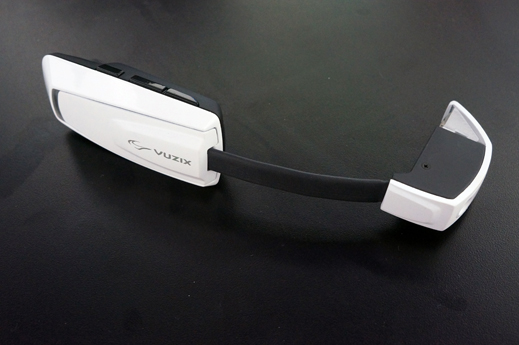Hands-On with the Vuzix M100, a Google Glass Competitor
Standing on the floor of the Consumer Electronics Show yesterday, I saw a mass of lanyard-yoked electronics industry workers struggling to make sense of an event boasting 150,000 attendees and 200,000 new products. But when I shifted my attention to the gadget clipped to my right ear, I saw a neat line of app shortcuts on a tiny digital display in front of my right eye. I flipped my attention between the two sights a few times—something I found surprisingly easy—and wondered whether this would soon be normal.

I was trying out a wearable display called the M100, made by Vuzix, a small company that has for some years made such displays for the defense industry. Vuzix, which is based in Rochester, New York, announced the device in November (see “Google’s Glass Gets a Competitor”); it sounded as if it would be similar to Google’s prototype wearable display (see “You Will Want Google Goggles”).
This week at CES, Vuzix made a few of its devices available to try out, albeit in a limited way because they are still under development. Google, it is worth noting, has so far shown its Glass prototypes to very few people, although some of the company’s employees wear them in public (see “We Spot Google’s Goggles on the Streets of San Francisco”).
The Vuzix device looks like a hands-free headset that has sprouted an extra part—a ribbonlike boom that holds a small prism in front of the wearer’s eye and directs the light from a tiny display toward it. The boom is bendable, making it easy to position the display so that it’s relatively unobtrusive when you want to look directly at it.
When I did direct my attention to that display, it provided a bright, clear image that was easy to focus on even though it was visible only to my right eye (using the M100 for a long period might change that assessment). It appeared about as big as the display of a four-inch phone screen held at arm’s length. The spectacles I was wearing didn’t seem to cause any problems. Video played by the display was bright and seemed smooth, although this one-eyed mode of viewing is better suited to mostly static imagery.
I saw evidence that a version of Google’s Android operating system (specifically, Ice Cream Sandwich) could be controlled over Bluetooth and using the three buttons on the earpiece, but Vuzix wasn’t ready to show apps built for the device. Browsing and selecting apps from the M100’s grid is easy using the buttons, but the apps installed were regular Android ones, unusable on the small landscape display that the device presents to a user.
“The apps really need to get rewritten for this because the interface is so different,” says the company’s CEO, Paul Travers.
The core parts of the M100’s software are in place and working, though. When you turn on the device for the first time, you are prompted to pair it with your phone over Bluetooth, and to install the companion app from the Android store. The current version of that app (which is still being finalized) has an upper part that mirrors exactly what can be seen through the wearable display.
“We’re using the phone as the interface,” says Travers. He imagines that some apps for the M100 will use the phone as a second display, to show more detail or provide finer controls if needed. For example, an app might record video from the M100, and allow a person to grab still photos with the unit’s built-in buttons, but offer more detailed controls—for sharing clips or the live stream—on the phone itself.
The M100 I tried showed Amazon’s price-check app, which looks up products from a photo of a bar code, and a video recording app. I didn’t get to test either one, but both are examples of functions that would make sense for a wearable device. Most of Google’s demonstrations of Glass have centered on streaming live video from the point of view of people wearing the device.
Travers says the M100 is far from ready for general sale, but he believes it shows that the design is plausible and something people might use: “It’s not necessarily ready for everyone today, but it has some real use cases.” He adds that developer kits have already begun shipping to the “thousands” who expressed interest when Vuzix announced the device last November.
It is likely that Google has a far larger team working on Glass than Vuzix does on the M100. But Travers says his company will survive because there will be a large market for wearable display devices, and he says he is open to licensing the design to large electronics manufacturers.
Keep Reading
Most Popular
Large language models can do jaw-dropping things. But nobody knows exactly why.
And that's a problem. Figuring it out is one of the biggest scientific puzzles of our time and a crucial step towards controlling more powerful future models.
How scientists traced a mysterious covid case back to six toilets
When wastewater surveillance turns into a hunt for a single infected individual, the ethics get tricky.
The problem with plug-in hybrids? Their drivers.
Plug-in hybrids are often sold as a transition to EVs, but new data from Europe shows we’re still underestimating the emissions they produce.
Stay connected
Get the latest updates from
MIT Technology Review
Discover special offers, top stories, upcoming events, and more.